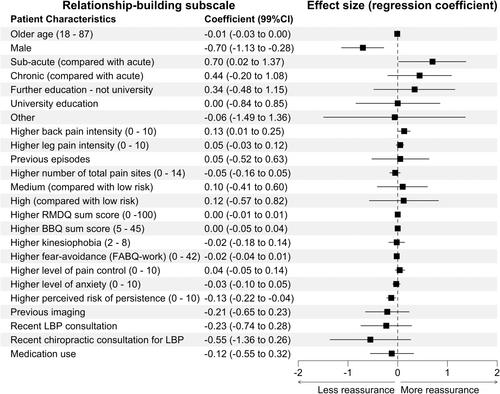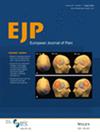Patient Characteristics Are Associated With Differences in Perceptions of Reassurance After a Consultation for Low Back Pain: Analysis of an Observational Study in Primary Care
Abstract
Background
People with low back pain (LBP) report different perceptions of reassurance after a consultation. We aimed to determine whether patient characteristics are associated with differences in patient perceptions of reassurance.
Methods
Secondary analysis of 2048 adults presenting with back pain to a chiropractor. We used linear mixed models to determine associations between patient sociodemographic, clinical and psychological characteristics and the outcome of reassurance measured using the four subscales of the Consultation-based Reassurance Questionnaire (CRQ).
Results
Patients with higher perceived risk of pain persistence reported perceiving less reassurance in their consultation, on all four subscales of the CRQ: data-gathering (regression co-efficient −0.13 [99% confidence interval: −0.23, −0.03]), relationship-building (−0.13 [−0.22, −0.04]), cognitive reassurance (−0.20 [−0.30, −0.10]) and generic reassurance (−0.27 [−0.39, −0.15]). Older age was associated with lower cognitive reassurance (−0.03 [−0.05, −0.01]) and generic reassurance (−0.04 [−0.07, −0.02]). Males were associated with lower relationship-building scores (0.70 [−1.13 to −0.28]), compared to females. Previous spinal imaging was associated with lower generic reassurance (−0.68 [−1.28, −0.09]). Compared to acute pain, higher levels of reassurance were perceived by patients with subacute pain [data-gathering (0.83 [0.10, 1.65]), relationship-building (0.70 [0.02, 1.37]), cognitive reassurance (0.87 [0.11, 1.56])]. Higher back pain intensity was associated with higher levels of relationship-building (0.13 [0.01, 0.25]) and generic reassurance (0.18 [0.02, 0.34]).
Conclusion
People with higher perceived risk of pain persistence, previous spinal imaging, male and older age perceived slightly lower levels of reassurance. The impact of these associations on the success of a LBP consultation is unclear.
Significance Statement
People seeking care for LBP report receiving variable levels of reassurance from healthcare providers. It is unknown whether perceived reassurance may differ according to patient characteristics. We identified several patient characteristics associated with lower perceived reassurance during a consultation for LBP, including higher perceived risk of pain persistence, previous imaging for LBP, males, older age, acute pain and lower LBP intensity. Knowledge of these characteristics may help inform optimal delivery of individualised patient reassurance.


 求助内容:
求助内容: 应助结果提醒方式:
应助结果提醒方式:


